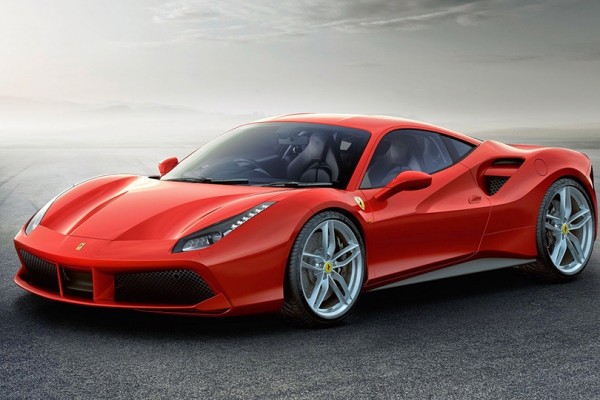A new Ferrari is always
an interesting piece of news, but the fact that this is the replacement for the 458, one of the best and most successful Ferraris ever made, does make you sit up and pay a bit more attention than usual.
It will be launched at the upcoming Geneva Motor Show in March, precisely 40 years after the 308 GTB which was Ferrari’s first mid-engined car with a V8. In that time, a lot has changed.
![]()
At first glance, the 488 GTB looks almost too similar to the old 458. The front end in particular looks almost exactly the same as the old car. You’d expect that from a Porsche 911, but not so much the new mid-engined small Ferrari. It did get a gorgeous new F12-style backside and huge air inlets for the intercoolers as the engine is now turbocharged. The turbocharging alone would’ve been be quite a shock to our system if we didn’t already know for years that it was coming.
![]()
The Ferrari California T was the first modern Ferrari to get the new turbo engine, and it was widely seen as a bit of an experiment before they put the engine in their full-on crazy performance models. As I’ve talked about before, turbocharging is the future thanks to all those environmental efficiency laws that car makers have to abide. On the one hand, turbos do make it easier to deliver huge power and torque from a smaller engine. On the other, however, is the fact that turbocharging compromises the character of the engine somewhat. Slower throttle response, non-linear power delivery and a less exciting sound are some of the «features» of a typical turbocharged engine. But you do get more power and a lot more torque whilst using less fuel on ordinary trips to the supermarket.
![]()
Don’t get me wrong, I love turbocharged cars. Nearly every car I’ve ever owned has been turbocharged. But if you’ll allow me to make a flawed analogy, a small turbocharged engine is sort of like following your dietician’s advice. Eat your salad and raw vegetables, it’s good for you even in big portions.
A large turbocharged engine is a lot like a big fat hamburger. Not particularly elegant or sophisticated, but it can be pretty good nonetheless. And then we come to the endangered species of the large natually aspirated engine. Like Ferrari’s old 4.5 liter V8 in the 458 which produces 560 horsepower without any turbo trickery, just a lot of rpm and a noise that makes the hairs on your arms stand up to see what on earth is going on. These kind of engines are the Vienna Philharmonic Orchestra of the car world. The 3-star Michelin. And they are becoming extinct.
Most new cars are now coming with turbocharged engines. Even when you’re shopping at BMW, Audi or Mercedes you will struggle to find a car without one. One by one, they are retiring their most revered old engines and introducing more boringly efficient ones. Mercedes has stopped using its 6,3 litre V8, the big lovable lump of an engine which used to reside in the C63 AMG.
All BMW M cars are now turbocharged. I don’t even know which of their engines I miss more, the old straight six, V8 or the howling big V10. But they are all gone. Audi still has V8 and V10 engines which rev to more than 8,000 rpm but those the last ones. And certainly the V8 will not survive much longer.
That’s not even the worst of it. Porsche is working hard on the 991.2 version of the 911 and it will also be fully turbocharged. Not just the 911 Turbo, obviously, but also the base Carrera and Carrera S will have turbos. Is nothing in this world sacred? It would appear not. I’m not sure I’ve ever driven a nicer engine than the one found in the Carrera S, and there is no way a turbo will make it better. The turbo revolution is the equivalent of closing all Michelin star restaurants and replacing them with the kind of place that prints the ingredients and calorie count on their menus.
I guess I forgot that I was supposed to talk about a new Ferrari there for a minute. Sorry viewers. I mean, readers. Have a look at that lovely rear end…
![]()
Surely there must be some good news as well about the new kid from Maranello? Well, the 488 GTB is going to be a lot faster than the 458 Italia was. I have to put that little fact in the «win» column, definitely. It looks like it’s going to be ridiculously fast actually. Zero to 200 km/h in 8,3 seconds. Even just a few years ago performance like that was unheard of. Where do you use it? I struggle to use 400 horsepower for more than a few seconds here in Moscow.
And there lies the problem. It doesn’t matter if you are talking about a new Ferrari, a Porsche or a Nismo GT-R, every new version of a car must be faster than the one it replaces. Otherwise it «looks» like you’re going backwards. It looks that way to the kind of people who start arguing with each other in the comments section of a youtube video. People who will never in their wildest dreams actually own these cars. It’s a game of shouting numbers and the biggest one is the best. Can you imagine what would happen if Ferrari made a new car that was slower than the old one? And thus slower than, say, the new Lamborghini? Of course not.
![]()
So we are reaching a point where a small and light Ferrari has six hundred and seventy horsepower. Six. Seven. Zero. I’m not that old, and I grew up thinking 200 horsepower was quite a lot. Then 300. And so on and so forth. The people who drive these cars for a living and make videos about them will be raving on about how incredibly fast and amazing it is. The people in the comments section will still be arguing about whether you shouldn’t just buy a much cheaper GT-R and crank it up to a thousand horsepower or so. But did the people who actually own a 560-horsepower Ferrari 458 ever think «you know, I like this car, but I wish it was a bit faster.» ? I doubt it.
![]()
It seems that the full specification of these cars can only ever be used in meaningless debates with people you don’t know. I mean, where would you use it? You can’t use it in the city, surely. You’d be breaking the law within 2 seconds of planting your right foot into the carpet. And I personally would never break the law, that much goes without saying. Even if you go onto the highway, you’ll be breaking the speed limit after 3 and a bit seconds. So what do you do? Wake up at 04:00 in the morning to go and make the MKADburgring a bit less safe? A racetrack is always a good idea but how often can you go there?
I will also point out that the people who buy these kind of cars aren’t actually ex-racing drivers themselves. Not like all those blokes on TV and YouTube. So in an effort to prevent their customers crashing their new cars as soon as they leave the showroom, there’s a million safety programs running to keep you and your driving talent out of ditches. Basically they are slowing the car down and reducing power when there isn’t enough grip, because normal humans aren’t actually capable of controlling the huge stable of horses at their disposal. Maybe that’s a sign that we’ve gone far enough for a while in terms of power? Food for thought.
If you don’t mind me talking about the new 488 GTB again for a moment, Ferrari says it has made a considerable effort to make the turbo engine feel like a naturally aspirated one. This was already obvious with the California T where the engine programming was trying to imitate the power delivery of a naturally aspirated engine. Clearly Ferrari has spent years trying to make these new engines feel as much like the old ones as possible. Peak power even comes at 8,000 rpm which is highly unusual for a forced induction engine.
![]()
Still, it’s not like their actual customers will buy any less cars because of it anyway. Even when Ferrari stopped making cars with manual gearboxes they only kept selling more cars regardless of how sad everyone was about having to buy a semi automatic. Well, when I say «everyone» I mean everyone who would never buy a Ferrari anyway. The actual customers didn’t seem to mind at all. In fact, with now Ferraris were actually easy to drive, they only sold more of them.
Does all that mean the 488 GTB going to be no good then? No, it’s going to be bloody awesome. Sorry if I wasn’t clear on that from the beginning.











